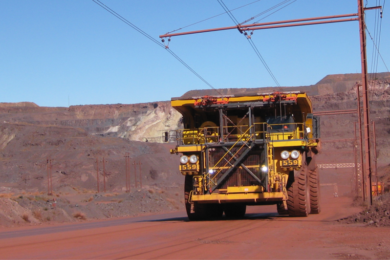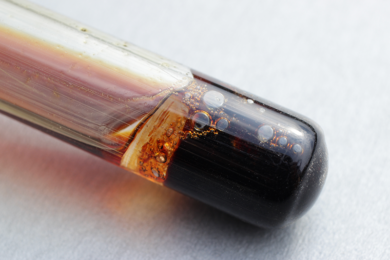A new bill is being put forward requesting state funding of $10 million for an overall $25 million trolley assist mining truck demonstration project at US Steel’s Minntac iron ore (taconite) mine in Minnesota, with a recent hearing held on March 1 before the Minnesota Senate’s Energy, Utilities, Environment and Climate Committee.
Supporting speeches were given by David Chura, Manager of Emerging Initiatives at Minnesota Power which would receive the funding; Ed Faulk, Komatsu Mining Corp Manager of Business Development; Kristen Vake, Executive Director of the Iron Mining Association of Minnesota; and John Arbogast, Staff Representative for United Steelworkers District 11.
The bill proposes $10,000,000 in fiscal year 2024 to be “appropriated from the general fund to the commissioner of commerce for a grant to an electric utility serving a taconite mine in Minnesota. The purpose of the grant under this section is to provide money and support matching funds required for a federal grant award under the Infrastructure Investment and Jobs Act, Public Law 117-158, that funds a pilot project to demonstrate the economic, energy, and environmental benefits of constructing an electric trolley system that powers large trucks carrying mined rock out of the mine pit and transports the mined rock to nearby crushing operations.” The wording says the money may be used to (1) construct the trolley system, wires, a substation, and related equipment; and (2) modify trucks for compatibility with the trolley system. It adds that this would be a one time appropriation.
Minnesota Power’s Chura said: “There’s been considerable focus in the state on the policy to transition passenger vehicles and buildings to cleaner electric service. We are excited to be here today to talk about mine truck electrification and the potential for all Minnesota to realise the benefits of electrification at an industrial scale through a demonstration project.”
He said that in the US Steel demonstration project analysis based on the Minntac mine and the Komatsu 240 ton 830E truck, adding trolley assist to Tier IV mine trucks reduces CO2 by 14,359 t when supplied with 100% carbon free electricity plus the trucks burn 95% less diesel when on the trolley line. To achieve those same reductions, it would require electrifying 3,122 gasoline passenger vehicles, or 520 passenger vehicles per mine truck. This is the equivalent of increasing the number of EVs in Minnesota by 14%. Chura said that it would also result in reduced emissions near key Class I airsheds, such as the Boundary Waters Canoe Area Wilderness, Voyageurs National Park, and several defined areas of environmental justice.
Equipment needs were cited as new electric drive mine trucks (~$6 million each) and/or modification of existing electric drive mine trucks (~$1.1 million each) with trolley infrastructure costs of ~$5 million/mile including overhead powerline and poles/support structure, power rectifier station/portable substation and service extension to the trolley line substation.
Chura added: “Additionally mine truck electrification has the ability to enable additional interruptible electric load which can react quickly in response to the variable output from renewable generation, thus helping to further integrate renewable energy while keeping costs down for customers. State and federal support is needed to help enable this demonstration project to help offset some of the challenges the economics face given lower price fuel and flatter haul grades in Minnesota than exist in other parts of the world where trolley assist operations are in place today. Infrastructure and equipment needs include new or modified electric drive trucks that have a pantograph on top to connect to the trolley line; the trolley line itself including a power rectifier and substation, and service extension to the trolley line. Just as the state has helped incentivise residential and commercial electric vehicle service, state support would leverage dollars from the DOE to achieve the benefits of electrification at an industrial scale.”
Ed Faulk at Komatsu Mining said: “We have extensive experience with mine truck electrification through implementation of trolley systems such as those working at Copper Mountain in Canada and Boliden, which has operations in Finland and Sweden. Komatsu is working diligently to support customer requests to provide equipment solutions with lower carbon emissions through technology development and power source flexibility in haul truck design. Our product development that is in development now includes haul trucks that can be powered by several options including diesel engines, batteries and potentially other methods that we haven’t seen yet or been developed yet. Regardless of the power source, our new trucks will have a trolley option and will be able to be converted to new technology as it is developed going forward through our power agnostic platform.”
He added: “Trucks operating on a trolley line may burn up to 95% less diesel fuel and can see a significant improvement in speed on grade with the power that is supplied by the trolley, thereby increased mine operators’ production too. Depending on the application, Komatsu haul trucks equipped with trolley can experience an overall reduction of 70% in diesel fuel consumed…at Komatsu we are building on a 30 year history of trolley innovation as part of our path to a zero emissions future. World-wide, Komatsu has sold over 250 electric drive haul trucks equipped with trolley assist, and are currently engaged in over 200 enquiries for more. Those opportunities exist throughout the world. This demonstration project would be the first trolley assist operation in a taconite mine in the United States; and at the largest taconite mine in Minnesota. Additionally, it would be the first electric trolley assist operation in the United States. You can help enable this transition and support the ongoing advancement of increasingly sustainable solutions for obtaining essential minerals.”
Barrick’s Goldstrike in Nevada did operate with trolley assist from 1994 to 2001 but this would be the first new installation of its kind in the US.










